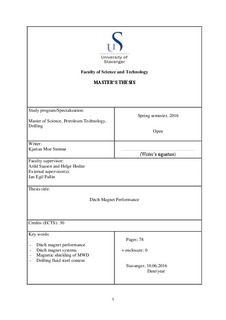| dc.contributor.author | Moe Strømø, Kjartan | |
| dc.date.accessioned | 2016-09-21T08:16:52Z | |
| dc.date.available | 2016-09-21T08:16:52Z | |
| dc.date.issued | 2016-06-10 | |
| dc.identifier.uri | http://hdl.handle.net/11250/2409076 | |
| dc.description | Master's thesis in Petroleum engineering | nb_NO |
| dc.description.abstract | Magnetic shielding of the Measurement While Drilling (MWD) directional tools and damages to mud pumps, downhole tools and casing/drill-pipe are some of the main problems caused by steel and magnetic contaminated drilling fluids. The magnetic shielding of the MWD directional tool have so far shown to be the biggest problem caused by magnetic particles in the drilling fluid. For directional drilling surveys, it has been found that magnetic particles in the drilling fluid may cause errors in the azimuth in the range of 1-2° [1]. This error may cause the directional driller (DD) to miss his pre-set target within the range of 1-200 meters while drilling long deviated wellbores. In order to have the magnetic shielding problem eliminated, it has been found to be the best practice, to completely remove all the magnetic contaminants from the drilling fluid by the use of ditch magnets. The presented work has been done in order to better understand the importance of the magnets and their ability to remove magnetic waste from the drilling fluid. Experiments, together with analysis of the different parameters that might affect the ditch magnet performance have been conducted.
In the presented report, a simple TRU-WATE™ Fluid Density Balance weight was used to measure the density differences upstream and downstream of the ditch magnets. This was done in order to see if there was any noticeable difference in density upstream and downstream of the magnets. It was assumed that any changes in density could represent the performance of the ditch magnet. It was found that uncertainties and unknown features related to the experiments made the test results unreliable and hard to interpret. No results indicated that it was possible to actually quantify the ditch magnet performance by use of the TRU-WATE™ Fluid Density Balance weight.
A Scanning Electron Microscope (SEM) was used to determine the size of the smallest particles extracted from the drilling fluid by the two different ditch magnet systems and the quantity of the smallest particles. It was found that the smallest particles extracted by M.A.P.S and EZ-Clean ditch magnets was 0.5 and 0.8 micrometers. The quantity of the smallest particles was not found.
Data from the same ditch magnet systems that was used for the experiments have been analyzed in order to see if there are any significant differences in the total amount of magnetic waste material collected from the two systems. All data are seized from the daily drilling reports (DDR) provided by Det Norske Oljeselskap ASA. From the results, the ditch magnet performance is evaluated. It has been shown how drilling length, inclination and casing size may affect the production of magnetic debris, and hence, show the dependence of the performance of the ditch magnets. Methods related to handling of the ditch magnet samples have also been found to affect the final ditch magnet weight results and from this, the overall ditch magnet performance.
The report presents, in addition to the experiments and analysis, the importance of the ditch magnets and an overview of the most common ditch magnet systems that are used in operation today. Different types of ditch magnets are discussed and information is given concerning each system. | nb_NO |
| dc.language.iso | eng | nb_NO |
| dc.publisher | University of Stavanger, Norway | nb_NO |
| dc.relation.ispartofseries | Masteroppgave/UIS-TN-IPT/2016; | |
| dc.rights | Navngivelse 3.0 Norge | * |
| dc.rights.uri | http://creativecommons.org/licenses/by/3.0/no/ | * |
| dc.subject | petroleum engineering | nb_NO |
| dc.subject | petroleumsteknologi | nb_NO |
| dc.subject | drilling technology | nb_NO |
| dc.subject | ditch magnet performance | nb_NO |
| dc.subject | ditch magnet systems | nb_NO |
| dc.subject | magnetic shielding of MWD | nb_NO |
| dc.subject | drilling fluid steel content | nb_NO |
| dc.subject | boreteknologi | nb_NO |
| dc.title | Ditch Magnet Performance | nb_NO |
| dc.type | Master thesis | nb_NO |
| dc.subject.nsi | VDP::Technology: 500::Rock and petroleum disciplines: 510::Petroleum engineering: 512 | nb_NO |

